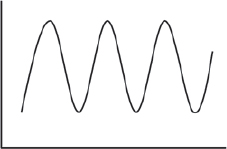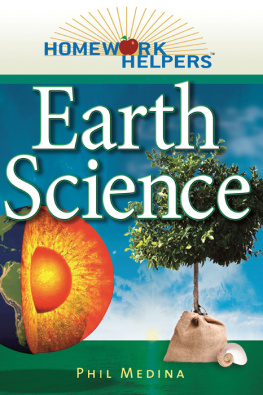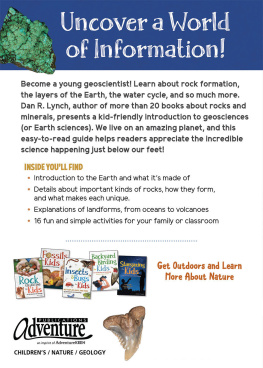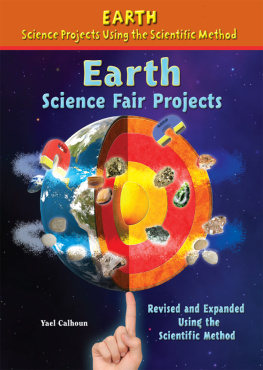

Copyright 2005 by Phil Medina
All rights reserved under the Pan-American and International Copyright Conventions. This book may not be reproduced, in whole or in part, in any form or by any means electronic or mechanical, including photocopying, recording, or by any information storage and retrieval system now known or hereafter invented, without written permission from the publisher, The Career Press.
HOMEWORK HELPERS: EARTH SCIENCE
EDITED BY KATHRYN HENCHES
TYPESET BY EILEEN DOW MUNSON
Cover design by Lu Rossman/Digi Dog Design
Printed in the U.S.A.
To order this title, please call toll-free 1-800-CAREER-1 (NJ and Canada: 201-848-0310) to order using VISA or MasterCard, or for further information on books from Career Press.

The Career Press, Inc.
220 West Parkway, Unit 12
Pompton Plains, NJ 07444
www.careerpress.com
Library of Congress Cataloging-in-Publication Data
Medina, Phil, 1967
Homework helpers. Earth science / by Phil Medina.
p. cm.
Includes index.
ISBN 1-56414-767-3 (pbk.)
1. Earth sciences. I. Title.
QE28.M43 2005
550--DC22
2004058484
www.redwheelweiser.com
www.redwheelweiser.com/newsletter
Acknowledgments
Special thanks to my wife, Valerie, for her support and help she has given me while writing this book; my parents for opening every door that I ever wanted to walk through; Jessica Faust for offering me the opportunity to write this book; and John Hotz, the Queens Village Clockmaker, for opening my eyes to the wonders of nature and science that are all around us. In his basement clock shop I was the apprentice to DaVinci.
Thanks also to my high school French teacher, Gail Stein, for showing me that a true teacher strives to be a master of her subject; and to Becky Arthurs, Jon Quigley, Annette Goldmacher, and all of my students who inspire me to learn as much as I can and to be the best teacher I can possibly be.
Lastly, thanks to my colleagues at Murphy Junior High for surrounding me with experts from every field and allowing me to thrive. I would especially like to thank Pam, Conrad, and Barbara for their help with this book.
Contents
Introduction
Welcome to Homework Helpers: Earth Science
Homework Helpers: Earth Science was written for the students who need a different presentation of Earth Science than what they've seen in class. This book is written less as a textbook and more as a conversation between the reader and a tutor.
Earth Science is the study of our natural surroundings of which we all have some familiarity. However, the important connections are often lost in the dry facts and abstract concepts. The discussions and examples in this book will give the reader the oh, of course! That makes sense, reaction.
This book is not to be read in one sitting or even in the order that it is presented. It is written as a supplement to your classroom experience. Pick up this book and review each topic as you work on it in class or in preparation for the chapter test. If you are finding your class particularly difficult, it will also come in handy to preview the topic before you see it in class.
Each section has practice questions and exercises designed to reinforce the new material. After the practice sections, you will find the answers and explanations of correct as well as incorrect answers. At the end of each chapter, there is a chapter test also accompanied by explanations of the answers.
Earth Science is something we are all immersed in every day and should not be a foreign subject. A firm grasp of the concepts of how our world works makes us partners in a relationship with nature, rather than victims of it.

Introduction to Earth Science
Lesson 11: Observation and Inference
An observation is any information that is gathered by using any of the five senses. Observations are the facts that are used in science. They tend to be dry facts, measurements, and statistics. Think of observations as evidence.
A measurement is a form of an observation. This is referred to as comparing to a standard because the definition of the unit you are using, such as a meter, is a standardized distance. In order that all measurements agree with each other, the definition of that unit can be found somewhere. For example, in the state Bureau of Weights and Measures, there is a metal bar that is measured very accurately to be as exact as humanly possible to a meter. This bar is the standard meter. All other meter sticks are compared to this one bar for accuracy. Whenever you use a ruler to measure a distance, you are comparing to a standard. Even though your 49-cent ruler may not be the most accurate, it is a fairly close representation of that bar in the Bureau of Weights and Measures. By the way, this is a huge leap from the old days of measuring a cubit as the length from your elbow to the tip of your middle finger or a foot as being the size of the king's foot.
Some Examples of Observations
The Sun rises due east on March 21.
The rock has a hardness of 7 on Mohs scale of hardness.
There is a quarter Moon in the sky.

An inference is a conclusion that is made based on your observations. It will typically answer the question why or how. When you make an inference you put the evidence together and explain what happened or what will happen.
Some Examples of Inferences
The rock was transported, by a glacier.
This sample of granite cooled slowly from magma inside Earth.
Based on today's weather trends, it will rain tomorrow.

Lesson 11 Review
Identify each of the following statements as either an observation or an inference:
- The rock is dark brown.
- The Moon is 386,000 km away from the Earth.
- The Moon was created by a collision between Earth and another object in space.
- It's raining today.
- According to the graph, the world's population will double in 100 years.
- A glacier gouged out this valley.
- The wooly mammoth was hunted to extinction by primitive humans.

Figure 1.1. Cyclic Relationship
Lesson 12: Patterns of Change
In Earth Science we study many kinds of changes: changes in temperature, changes in the size of rocks as they wear down, the changing position of Earth throughout the year, and so on. Many of these changes follow some kind of pattern, which allows us to predict what will happen in the future.
A cyclic pattern is a repeating pattern. This is caused by repeating events and, when graphed, it appears as some version of a sine graph.
Next page













